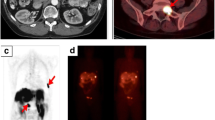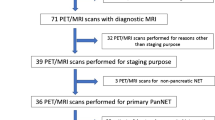Abstract
Purpose
To evaluate the diagnostic accuracy of 68Ga-DOTANOC PET/CT imaging in a large exclusive population of pancreatic neuroendocrine tumors (NETs).
Methods
Data of 141 (mean age 46.2 ± 15.2 years) patients who underwent 178 68Ga-DOTANOC PET/CT studies for diagnosis/staging (n = 88) and restaging (n = 90) of pancreatic NET were retrospectively analyzed. PET/CT results were compared to conventional imaging (CIM) when available (n = 86). Histopathology and/or clinical/imaging follow-up (minimum 6 months) were used as reference standard.
Results
The overall sensitivity, specificity, and accuracy of 68Ga-DOTANOC PET/CT were 85.7%, 79.1%, and 84.8%. The corresponding values were 73%, 50%, and 70.4% for diagnosis/staging groups and 98.6%, 100%, and 98.8% for restaging groups. The accuracy was significantly higher for restaging as compared to diagnosis/staging (P < 0.0001) and in non-insulinoma tumors than insulinomas (P < 0.0001). The SUVmax of primary tumors was significantly higher than metastatic lesions overall (P = 0.001), as well as in diagnosis/staging (P = 0.041) and restaging (P = 0.0003) subgroups. When available, CIM was less specific than 68Ga-DOTANOC PET/CT (P < 0.001) and showed fewer lesions.
Conclusions
68Ga-DOTANOC PET/CT is useful for diagnosis/staging and restaging of patients with pancreatic NET. It demonstrates more lesions compared to CIM and is more specific.





Similar content being viewed by others
References
Yao JC, Hassan M, Phan A, et al. (2008) One hundred years after “carcinoid”: epidemiology of and prognostic factors for neuroendocrine tumors in 35,825 cases in the United States. J Clin Oncol 26:3063–3072
Oberg K, Eriksson B (2005) Endocrine tumours of the pancreas. Best Pract Res Clin Gastroenterol 19:753–781
Nissen NN, Kim AS, Yu R, et al. (2009) Pancreatic neuroendocrine tumors: presentation, management, and outcomes. Am Surg 75:1025–1029
Kitajima K, Murakami K, Yamasaki E, et al. (2010) Performance of integrated FDG-PET/contrast-enhanced CT in the diagnosis of recurrent pancreatic cancer: comparison with integrated FDG-PET/non-contrast-enhanced CT and enhanced CT. Mol Imaging Biol 12:452–459
Oda Y, Tanaka Y, Naruse T, Sasanabe R, Tsubamoto MFH (2002) Expression of somatostatin receptor and effects of somatostatin analog on pancreatic endocrine tumors. Surg Today 32:690–694
Buchmann I, Henze M, Engelbrecht S, et al. (2007) Comparison of 68Ga-DOTATOC PET and 111 In-DTPAOC (octreoscan) SPECT in patients with neuroendocrine tumours. Eur J Nucl Med Mol Imaging 34:1617–1626
Krausz Y, Rubinstein R, Appelbaum L, et al. (2012) Ga-68 DOTA-NOC uptake in the pancreas: pathological and physiological patterns. Clin Nucl Med 37:57–62
Grant CS (2005) Insulinoma. Best Pract Res Clin Gastroenterol 19:783–798
Zimmer T, Stölzel U, Bäder M, et al. (1996) Endoscopic ultrasonography and somatostatin receptor scintigraphy in the preoperative localisation of insulinomas and gastrinomas. Gut 39:562–568
Geijer H, Breimer LH (2013) Somatostatin receptor PET/CT in neuroendocrine tumours: update on systematic review and meta-analysis. Eur J Nucl Med Mol Imaging 40:1770–1780
Kumar R, Sharma P, Garg P, et al. (2011) Role of (68)Ga-DOTATOC PET-CT in the diagnosis and staging of pancreatic neuroendocrine tumours. Eur Radiol 21:2408–2416
Schmid-Tannwald C, Schmid-Tannwald CM, Morelli JN, et al. (2013) Comparison of abdominal MRI with diffusion-weighted imaging to 68Ga-DOTATATE PET/CT in detection of neuroendocrine tumors of the pancreas. Eur J Nucl Med Mol Imaging 40:897–907
Zhernosekov KP, Filosofov DV, Baum RP, et al. (2007) Processing of generator-produced 68 Ga for medical application. J Nucl Med 48:1741–1748
Al-Ibraheem A, Bundschuh RA, Notni J, et al. (2011) Focal uptake of 68 Ga-DOTATOC in the pancreas: pathological or physiological correlate in patients with neuroendocrine tumours? Eur J Nucl Med Mol Imaging 38:2005–2013
Naswa N, Sharma P, Kumar A, et al. (2011) Gallium-68-DOTA-NOC PET/CT of patients with gastroenteropancreatic neuroendocrine tumors: a prospective single-center study. AJR Am J Roentgenol 197:1221–1228
Wild D, Christ E, Caplin ME, et al. (2011) Glucagon-like peptide-1 versus somatostatin receptor targeting reveals 2 distinct forms of malignant insulinomas. J Nucl Med 52:1073–1078
Kumar U, Sasi R, Suresh S, et al. (1999) Subtype-selective expression of the five somatostatin receptors (hSSTR1–5) in human pancreatic islet cells: a quantitative double-label immunohistochemical analysis. Diabetes 48:77–85
Castellucci P, Pou Ucha J, Fuccio C, et al. (2011) Incidence of increased 68Ga-DOTANOC uptake in the pancreatic head in a large series of extrapancreatic NET patients studied with sequential PET/CT. J Nucl Med 52:886–890
Taïeb D, Neumann H, Rubello D, et al. (2012) Modern nuclear imaging for paragangliomas: beyond SPECT. J Nucl Med 53:264–274
Kayani I, Bomanji JB, Groves A, et al. (2008) Functional imaging of neuroendocrine tumors with combined PET/CT using 68Ga-DOTATATE (Dota-DPhe1, Tyr3-octreotate) and 18F-FDG. Cancer 112:2447–2455
Naswa N, Sharma P, Gupta SK, et al. (2014) Dual tracer functional imaging of Gastroenteropancreatic Neuroendocrine tumours using 68 Ga-DOTANOC PET-CT and 18F-FDG PET-CT: competitive or Complimentary? Clin Nucl Med 39:e27–e34
Kaltsas GA, Besser GM, Grossman AB (2004) The diagnosis and medical management of advanced neuroendocrine tumors. Endocr Rev 25:458–511
Gabriel M, Decristoforo C, Kendler D, et al. (2007) 68Ga-DOTA-Tyr3-octreotide PET in neuroendocrine tumors: comparison with somatostatin receptor scintigraphy and CT. J Nucl Med 48:508–518
Versari A, Camellini L, Carlinfante G, et al. (2010) Ga-68 DOTATOC PET, endoscopic ultrasonography, and multidetector CT in the diagnosis of duodenopancreatic neuroendocrine tumors: a single-centre retrospective study. Clin Nucl Med 35:321–328
Baum RP, Kulkarni HR (2012) THERANOSTICS: from molecular imaging using Ga-68 labeled tracers and PET/CT to personalized radionuclide therapy—the Bad Berka Experience. Theranostics 2:437–447
Koopmans KP, Neels OC, Kema IP, et al. (2008) Improved staging of patients with carcinoid and islet cell tumors with 18F-dihydroxy-phenyl-alanine and 11C-5-hydroxy-tryptophan positron emission tomography. J Clin Oncol 26:1489–1495
Haug A, Auernhammer CJ, Wängler B, et al. (2009) Intraindividual comparison of 68Ga-DOTA-TATE and 18F-DOPA PET in patients with well-differentiated metastatic neuroendocrine tumours. Eur J Nucl Med Mol Imaging 36:765–770
Mayerhoefer ME, Ba-Ssalamah A, Weber M, et al. (2013) Gadoxetate-enhanced versus diffusion-weighted MRI for fused Ga-68-DOTANOC PET/MRI in patients with neuroendocrine tumours of the upper abdomen. Eur Radiol 23:1978–1985
Acknowledgments
We sincerely thank Dr. Prashant Durgapal, Department of Pathology, All India Institute of Medical Sciences, New Delhi, India, for proving the pathology images.
Author information
Authors and Affiliations
Corresponding author
Rights and permissions
About this article
Cite this article
Sharma, P., Arora, S., Dhull, V.S. et al. Evaluation of 68Ga-DOTANOC PET/CT imaging in a large exclusive population of pancreatic neuroendocrine tumors. Abdom Imaging 40, 299–309 (2015). https://doi.org/10.1007/s00261-014-0219-5
Published:
Issue Date:
DOI: https://doi.org/10.1007/s00261-014-0219-5




